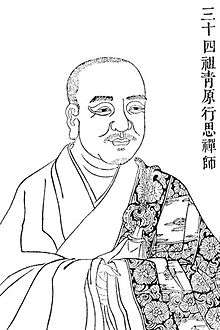Qingyuan Xingsi
| Qingyuan Xingsi 青原行思 | |
|---|---|
 | |
| School | Chán |
| Personal | |
| Born |
660 Jiangxi, China |
| Died | 740 |
| Senior posting | |
| Title | Chán master |
| Predecessor | Dajian Huineng |
| Successor | Shitou Xiqian |
| Religious career | |
| Teacher | Dajian Huineng |
| Students | Shitou Xiqian |
Qingyuan Xingsi (Chinese: 青原行思; pinyin: Qīngyuán Xíngsī; Japanese: Seigen Gyōshi; Korean: Chǒngwǒn Haengsa; Vietnamese: Thanh Nguyên Hành Tư) was a Zen Buddhist monk during the Tang Dynasty. Three of the five traditionally recognized houses of Zen are commonly believed to have developed out of his lineage: the Caodong/Sōtō, Yunmen/Unmon, and Fayan/Hōgen. There is scant information about his life. He is said to have lived in the Quiet Abode Temple on Mount Qingyuan.[1] The Transmission of the Lamp claims he was Huineng's foremost student, although this was written during the Song Dynasty over 200 years after Qingyuan's death.[2]:48 The earliest source of information about Qingyuan comes from the Zutang ji (Patriarch's Hall Record), which was completed in 952 by Wendeng.[3]:63 The scholar Albert Welter suggests that Wendeng may have invented Qingyuan in order to legitimize Shitou Xiqian, Qingyuan's supposed student, and in turn himself since he was descended from Shitou.[3]:73–75 Shitou's original teacher, Huineng, died when Shitou was only 13, so Qingyuan was necessary for him to receive legitimate dharma transmission.[2]:48
Biographical legends
As with most Tang Dynasty Zen monks, there are many vivid stories about Qingyuan's encounters with students and other teachers. They are almost certainly not historical events, however. The Transmission of the Lamp, for example, recounts the following:
When Shenhui of Ho Chen came to study with Qingyuan, the master asked where he was coming from, and Shenhui said from Cao Xi. "What's new in Cao Xi?" asked Qingyuan. When Shenhui remained silent, Qingyuan said, "Tiles and pebbles are still in your way". Shenhui asked, "Do you have true gold to give to others?" Qingyuan said, "Even if I had some, how would you hold on to it?"[2]:51
Another from the same source takes place as follows:
Once a monk asked, "What is the main teaching of Buddhism?" Qingyuan replied, "What is the price of rice in Luling?"[2]:51
References
- ↑ Ferguson, Andrew E. (2000), Zen's Chinese heritage: the masters and their teachings, Wisdom Publications, pp. 48–49, ISBN 978-0-86171-163-5
- 1 2 3 4 Mitchell, James (2005), Soto Zen ancestors in China, San Francisco: Ithuriel's Spear, pp. 48–51, ISBN 978-0-9749502-3-5
- 1 2 Welter, Albert (2006), Monks, rulers, and literati: the political ascendancy of Chan Buddhism, Oxford University Press, ISBN 978-0-19-517521-9
| Buddhist titles | ||
|---|---|---|
| Preceded by Dajian Huineng |
Sōtō Zen patriarch | Succeeded by Shitou Xiqian |